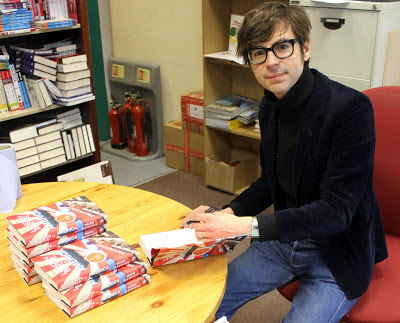I sat down for a chat with the lovely Travis Elborough,
author of London Bridge in America: The Tall Story of a Transatlantic Crossing,
to talk about one the most bizarre chapters in Anglo-American history: the upheaval and subsequent plonking of London Bridge in the Arizonan desert.
The London Bridges of old were famous for involuntarily falling down, but in 1968 the one built in 1831 - a far sturdier structure than its predecessors - was voluntarily dismantled, brick by brick, and transported to the Arizonan desert, where it was rebuilt for the benefit of holidaying Americans.
It's among the most bizarre stories of the 20th century, and one that author Travis Elborough has breathed new life into with his latest book, London Bridge in America: The Tall Story of a Transatlantic Crossing - a title that promises to reveal as much about Anglo-American relations as it does the 3,000-mile journey of a London landmark.
So, starting with the obvious question - why was London Bridge dismantled, sent across the Atlantic and painstakingly reconstructed somewhere at first glance non-descript, roughly equidistant from Phoenix and Los Angeles?
"London Bridge was put up for sale in 1967 after a decision that it no longer met the needs of London, which was becoming an increasingly mobile and motorised city," Travis explains.
"This was the swinging 60s, with lots of new buildings going up and huge plans for motorways. The bridge also happened to sinking slowly into the mud of the Thames by about an eighth of an inch a year. So it was put up for sale."
Step forward American businessmen Robert P. McCulloch and C. V. Wood - the former an oil baron and chainsaw entrepreneur; the latter a theme park designer who had a hand in Disneyland - the men bankrolling the development of Lake Havasu City, Arizona's latest purpose-built tourist resort. It had the golf courses, hotels and climate - but there was a certain something missing.
"They saw an opportunity in buying London Bridge," Travis adds, "a way of putting their new lakeside resort city on the map, by having this slice of old England in the middle of the desert."
So did the Corporation of London, which put the bridge up for sale, envisage it travelling to another continent? Or would they have rather seen a London icon remain in Britain?
"Canada was almost the preferred setting because it's Commonwealth country," Travis says. "But the person whose idea it was to sell London Bridge - a politician by the name of Ivan Luckin, was a bit of an Americanophile. He was a big admirer of William Randolph Hearst, who Orson Welles based his Citizen Kane character on, and who hoovered up architectural treasures across Europe before shipping them to his palace in California. Luckin certainly thought America as a likely destination."
And so it came to pass. Transaction complete; cue transatlantic diplomatic wrangling. "A bridge is one of those hilariously heavy with metaphor-type structures," Travis explains. "This is a book about cross-river traffic but also trans-Atlantic traffic, permeated with little stories about Anglo-American interconnections and relations.
"There's a rather poignant moment where the Americans are slightly unhappy with the speed of the bridge's transportation. To speed things up they brought in a Swedish firm - one of the forerunners of containerisation - at the same point London's docks are closing down because containerisation is killing them off."
London Bridge may no longer have been suitable for swinging London, but did a section of its forward-thinking population mourn its loss?
"They were surprisingly sanguine," Travis says. "The fact the bridge went up for sale fits into a particular element of London history at that time. Counteracting the thrusting modernity were the stirrings of a heritage and preservation movement. Just a few years before London Bridge was put up for sale was the classic case of the destruction of the Euston Arch - the original entrance to Euston Station - by the British Transport Commission, which sparked outrage. Shortly after, St Pancras Station was saved.
"The Corporation of London marketed the bridge's sale as an act of preservation; the alternative being its demolition. Looking through newspapers and commentaries of the time, most people weren't especially concerned about its departure. There were some snippier comments made when the Americans agreed to buy it - diary entries bemoaning its new location next to a golf course - so I suppose there's a certain English condescension."
By 1971, three years after it was bought, the re-erected London Bridge opened in Lake Havasu City (its replacement back in the capital, meanwhile, opened two years later in March 1973 - almost exactly 40 years ago). So how did its new surroundings compare with the murky Thames and the backdrop of London's financial district?
"It was initially erected on dry land and then water diverted through," Travis explains, " with Lake Havasu City soon becoming home to a pseudo English village, with a pub and a mock Trafalgar Square fountain.
"There's an extraordinary clip on YouTube of a variety show from 1972, a few months after the bridge had been formally re-opened, with Tom Jones and The Carpenters performing at Lake Havasu City. It's sold as a big resort - not very far away is Las Vegas, so it fits in with the pizzazzy idea of an attraction."


No comments:
Post a Comment